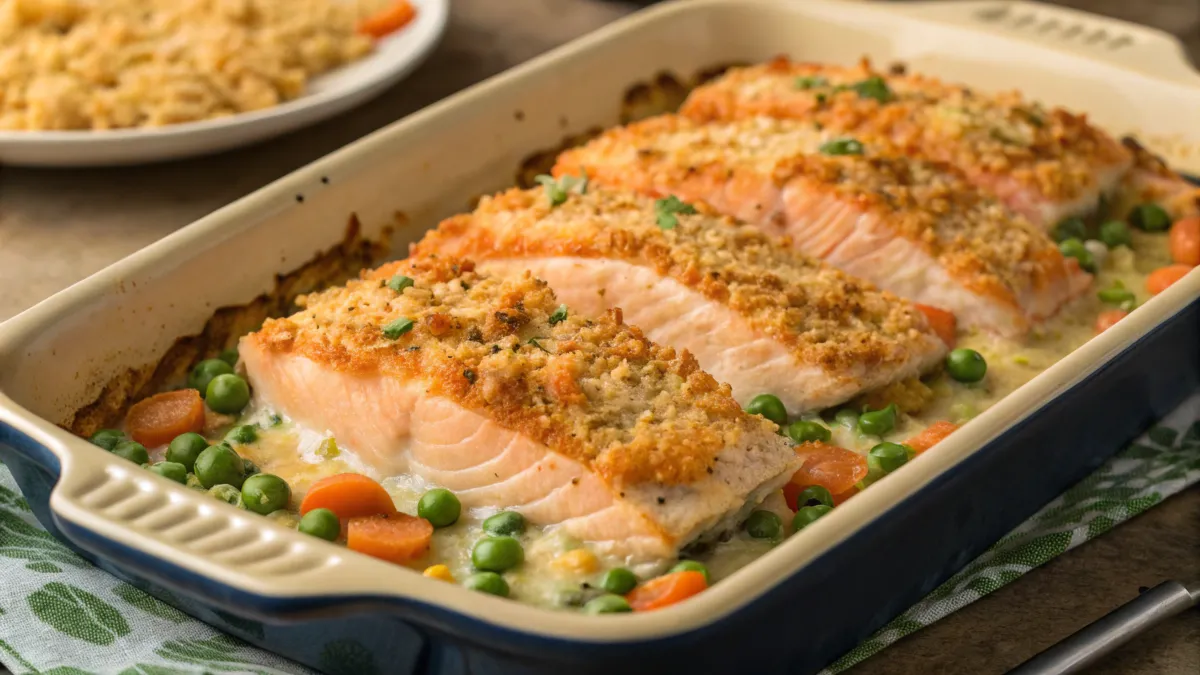Canned salmon is an incredibly versatile, nutritious, and convenient pantry staple. With its long shelf life and impressive nutritional value, it offers a quick and affordable protein source that’s perfect for busy individuals or families. Whether you’re preparing a light lunch, a hearty family dinner, or planning meals for the week, canned salmon simplifies cooking without sacrificing flavor. It’s packed with omega-3 fatty acids, high-quality protein, and essential nutrients like calcium and vitamin D, making it a healthy option for any meal. This guide will explore a variety of creative and easy canned salmon recipes, as well as helpful preparation techniques and tips to maximize its potential in your cooking. From simple salads to flavorful rice dishes, canned salmon is a delicious and nutritious addition to any kitchen.
Table of Contents
Key Takeaways
- Canned salmon is affordable, easy to store, and nutrient-dense, making it a versatile ingredient for simple, healthy meals.
- Recipes like salmon patties, salads, and rice bowls are quick and customizable, perfect for any occasion.
- Incorporating canned salmon into your diet can boost omega-3 intake and add essential vitamins and minerals to your meals.
Why Choose Canned Salmon?
Canned salmon stands out as a pantry staple due to its convenience and health benefits. Unlike fresh salmon, canned salmon is shelf-stable and ready to use, eliminating the need for thawing or extensive preparation. It’s an affordable protein source that retains many of the nutrients found in fresh salmon, including omega-3 fatty acids, protein, and calcium from its edible bones. For tips on why canned salmon should always be in your pantry, check out this detailed guide.
Preparation Tips
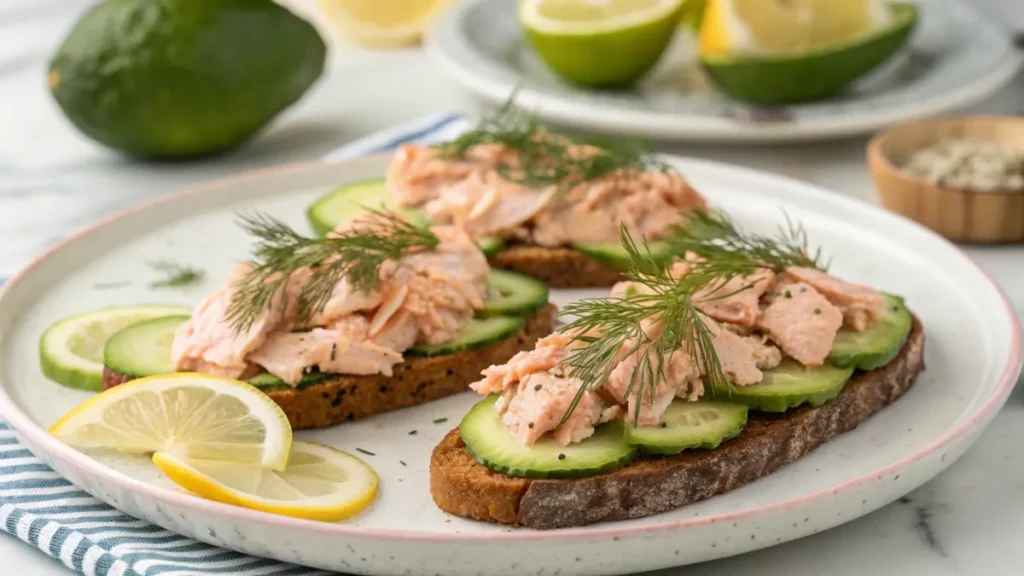
Preparing canned salmon is quick, simple, and requires very little effort, making it a great option for easy meals. Begin by draining the liquid, but don’t discard it just yet save it for future use in soups, sauces, or even gravies, as it can add extra depth and flavor to those dishes. If the canned salmon includes skin and bones, you have a couple of options. You can leave them in for the added nutritional benefits, such as calcium, or remove them if you prefer a smoother texture. For dishes like salads, patties, or pasta, gently flake the salmon with a fork to keep its structure intact. This also helps ensure the salmon is evenly mixed with your other ingredients, allowing the flavors and seasonings to distribute more evenly throughout your meal. The result is a delicious, nutritious dish with minimal preparation.
Simple Recipes for Any Occasion
Salmon Patties
Salmon patties are a classic way to transform canned salmon into a delicious and satisfying meal. These patties are quick to prepare and can be served as a main dish or in sandwiches.
Ingredients:
- 1 can of salmon, drained
- 1 egg
- 1/4 cup breadcrumbs or crushed crackers
- 1/4 cup finely chopped onion
- 1 teaspoon garlic powder
- 1/2 teaspoon paprika
- Salt and pepper to taste
Instructions:
Mix all ingredients in a bowl, form into patties, and pan-fry in oil until golden brown. Serve with a dollop of tartar sauce or on a bun with lettuce and tomato.
Canned Salmon Salad
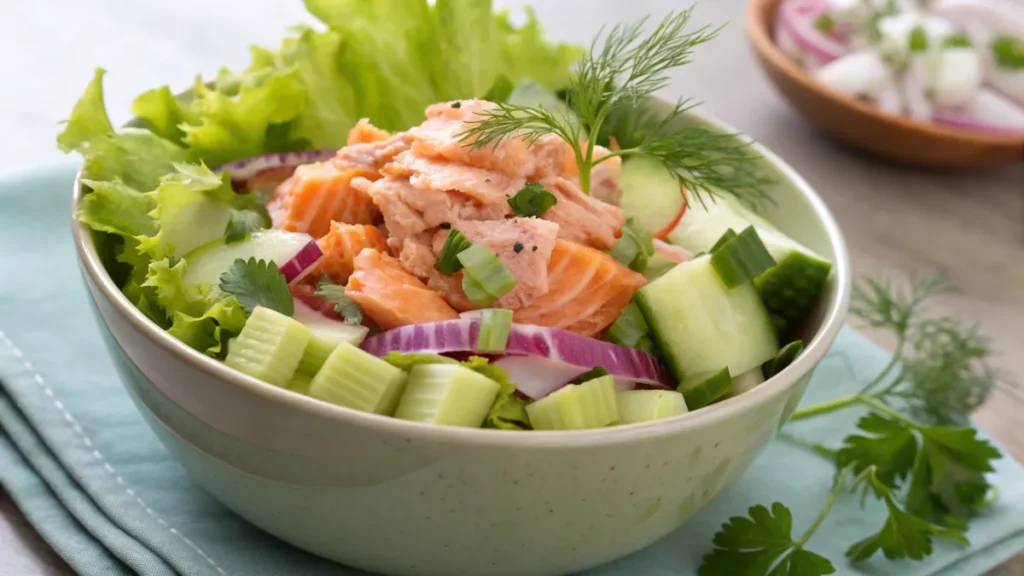
A refreshing salmon salad is perfect for a light lunch or as a filling for sandwiches and wraps.
Ingredients:
- 1 can of salmon, drained and flaked
- 1/4 cup mayonnaise or Greek yogurt
- 1 tablespoon Dijon mustard
- 1 celery stalk, finely chopped
- 1 teaspoon lemon juice
- Salt and pepper to taste
Instructions:
Combine all ingredients in a bowl and mix until well-blended. Serve on a bed of greens, with crackers, or as a sandwich filling.
Salmon Rice Bowl
A salmon rice bowl is a simple yet hearty dish that can be customized with your favorite vegetables and sauces.
Ingredients:
- 1 can of salmon, drained
- 2 cups cooked rice (white or brown)
- 1/2 cup steamed broccoli
- 1/2 cup shredded carrots
- Soy sauce or teriyaki sauce to taste
Instructions:
Layer the rice, salmon, and vegetables in a bowl. Drizzle with soy or teriyaki sauce, and sprinkle with sesame seeds for added flavor.
Salmon Pasta
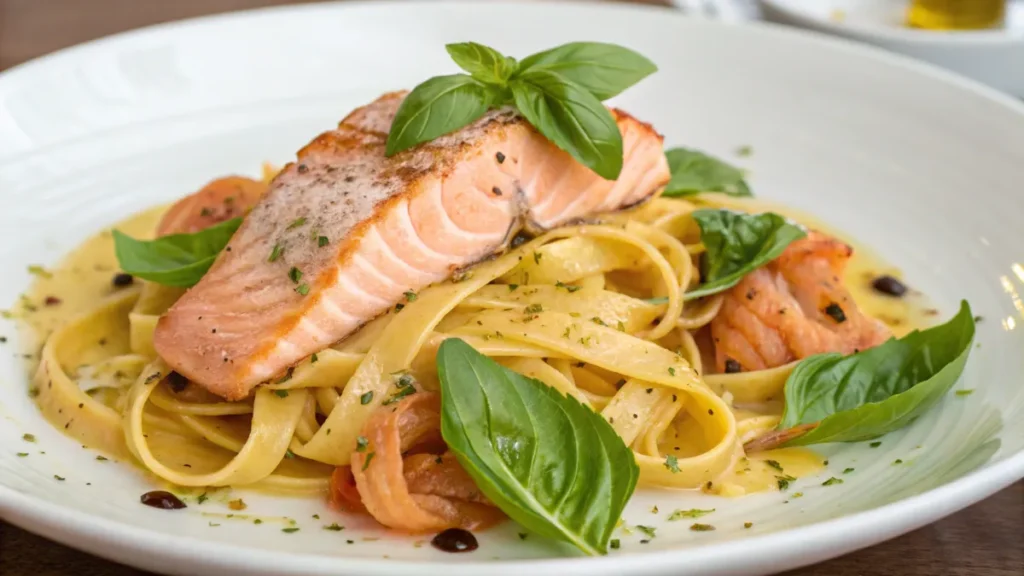
Salmon pasta is a creamy, comforting dish that comes together quickly.
Ingredients:
- 1 can of salmon, drained and flaked
- 8 ounces pasta of your choice
- 1 cup heavy cream or half-and-half
- 2 tablespoons butter
- 2 cloves garlic, minced
- 1/4 cup grated Parmesan cheese
- Salt and pepper to taste
Instructions:
Cook the pasta according to package instructions. In a skillet, melt butter and sauté garlic until fragrant. Add cream, Parmesan cheese, and seasonings. Stir in the salmon and cooked pasta, mixing until well-coated.
Baked Salmon Casserole
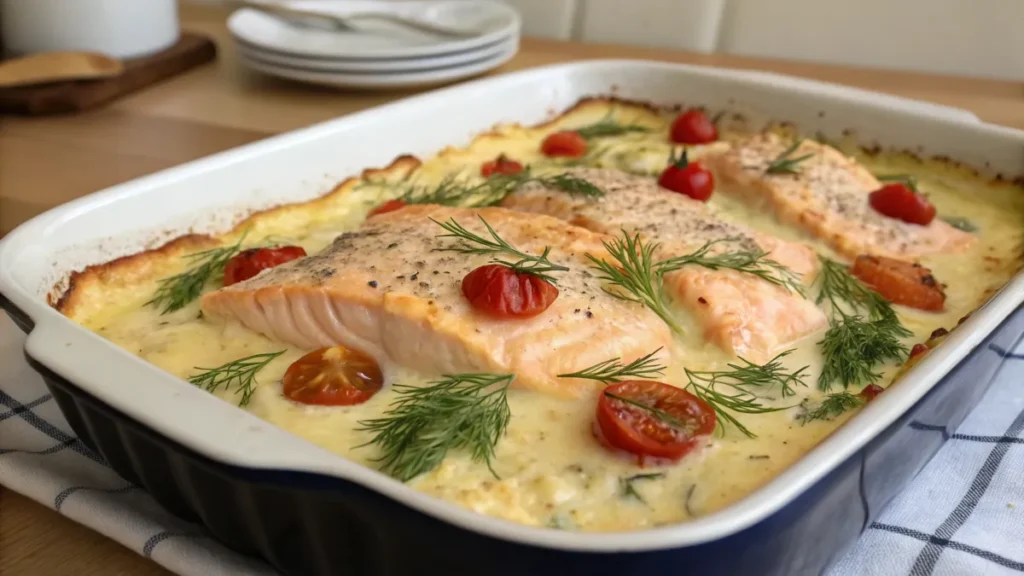
A baked casserole is a comforting option for a family dinner.
Ingredients:
- 1 can of salmon, drained and flaked
- 2 cups cooked rice or pasta
- 1 cup shredded cheese
- 1 can of cream of mushroom soup
- 1/2 cup milk
- 1/4 cup breadcrumbs
Instructions:
Preheat the oven to 375°F. Combine all ingredients except breadcrumbs in a baking dish. Top with breadcrumbs and bake for 20-25 minutes or until bubbly and golden brown.
Creative Meal Prep Ideas
Canned salmon is perfect for meal prep because it’s versatile and stores well. Prepare salmon patties or rice bowls in advance and refrigerate in airtight containers for up to three days. Incorporate salmon into meal prep salads with quinoa or couscous for a high-protein lunch option. Pair salmon with roasted vegetables or sweet potatoes for balanced, ready-to-eat meals throughout the week. For more ideas, check out this Canned Salmon Buddha Bowl recipe.
Nutritional Benefits of Canned Salmon
Canned salmon is a powerhouse of nutrients, providing omega-3 fatty acids for heart and brain health, high-quality protein for muscle repair, and calcium from its soft, edible bones. It’s also rich in vitamins like D and B12, which support bone health and energy production. Including canned salmon in your diet can contribute to overall well-being while offering a convenient, low-cost protein source. For more on its benefits, explore this guide to canned salmon nutrition.
Salmon tastes better with butter or oil, depending on your preference.
Salmon has a rich, natural flavor that pairs well with both butter and oil. Butter adds a creamy, rich taste, enhancing the fish’s flavor, while oil, especially olive oil, helps keep the salmon moist without overpowering it. Both options are great, but it depends on the texture and taste you prefer. Butter gives a slightly sweeter, more decadent flavor, while oil allows the fish’s natural taste to shine through.
Avoid overcooking salmon.
Overcooking salmon can make it dry and tough. To keep it moist and tender, cook it until it flakes easily with a fork. Salmon continues to cook after being removed from heat, so it’s best to take it off just before it reaches the perfect texture. Avoid high heat for too long, as this can dry out the fish and affect its flavor. A little attention to cooking time ensures a delicious, flaky salmon that retains its natural moisture.
Salmon pairs well with simple seasonings like lemon, garlic, and dill.
Lemon adds a refreshing, zesty kick, while garlic gives the fish a savory depth. Dill enhances the mild flavor of salmon, complementing its natural taste. These simple seasonings elevate the dish without overwhelming it. You can also add a pinch of salt and pepper for extra flavor or drizzle olive oil for a richer taste. These ingredients balance the salmon’s flavors and allow it to shine in a simple yet delicious way. Feel free to adjust the seasonings based on your personal preferences for a perfectly seasoned dish.
FAQs About Canned Salmon Recipes
Can I use canned salmon directly from the can?
Yes, canned salmon is fully cooked and ready to eat. You can use it directly in salads, sandwiches, or recipes.
Should I rinse canned salmon before using it?
Rinsing is unnecessary and can wash away nutrients. Simply drain the liquid and use the salmon as is. Learn more from this guide to handling canned fish.
How do I store leftover salmon dishes?
Store leftovers in an airtight container in the refrigerator for up to three days. Reheat gently to preserve texture and flavor.
Can I substitute canned salmon for fresh salmon in recipes?
Yes, canned salmon works well in most recipes as a substitute for fresh salmon, especially in cooked dishes like casseroles or pasta.
Are the skin and bones in canned salmon edible?
Yes, the skin and bones are soft and provide extra nutrients like calcium. If preferred, they can be removed easily.
Conclusion
Simple canned salmon recipes offer endless possibilities for creating nutritious, flavorful meals with minimal effort. From patties and salads to rice bowls and casseroles, canned salmon adapts to your needs, whether you’re cooking for one or feeding a family. By incorporating canned salmon into your meal rotation, you’ll enjoy a convenient, budget-friendly ingredient that supports a healthy lifestyle. For more inspiration, try out this Easy Canned Salmon and Rice Bake or experiment with a Canned Salmon Buddha Bowl. With these recipes and tips, canned salmon can become a staple in your kitchen, making every meal a delicious success.

